Introduction
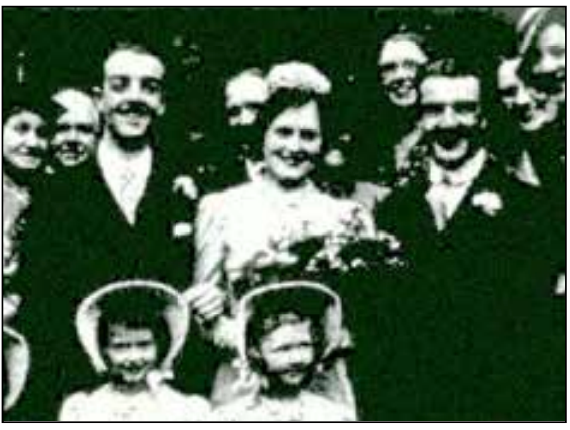
An eighteen-page John Hill & Co (Metal Toys) Ltd. catalogue dated January 1950 has recently been
discovered in Australia. Listing toy soldiers, cowboys and Indians, farm, zoo and civilian figures, it appears to be issued specifically for the export market. It shows some figures which were only in production for a brief period, including some which are very rarely found in circulation.
Post-War Johillco and 1950 Export catalogue
In late 1945 James Murdock Standing and Jack Cooper1 purchased the John Hill & Co. moulds from the Wood brothers. These had survived destruction following the Luftwaffe’s bombing of the Britannia Row works. Standing and Cooper relocated the John Hill & Co. business to northwest England into a solid old cotton mill building on Parliament Street, Burnley Wood Mill, in the English county of Lancashire. The toy soldier manufacture was set up in the same premises as the Veevers and Hensman printing works, owned and managed by the Standing brothers. The name of the toy business was changed slightly to John Hill & Co (Metal Toys) Limited.
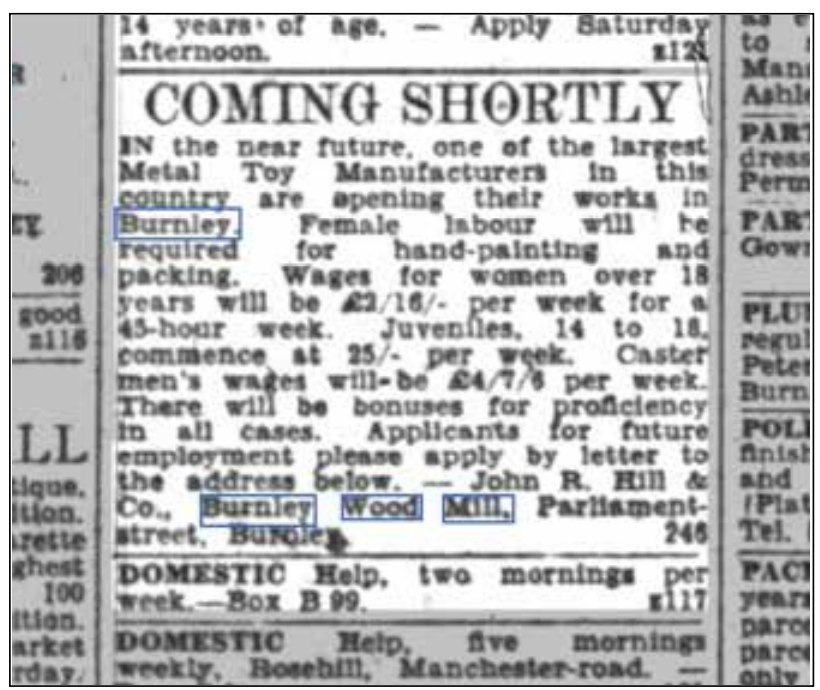
The wartime Limitation on Supplies Order on toys containing more than 10% metal was lifted on 1 July
19452, however the new British Labour government did not remove all restrictions on toy manufacture and retailing immediately. Shortages of other materials used in toy soldier manufacturing, including cardboard and wood for packaging, persisted. The government placed ceilings on the prices that both manufacturers and retailers could charge and purchase taxes continued to apply to the domestic sale of toys.3 The incentive for British toy soldier manufacturers in the immediate post-war period was to export as much product as possible to the larger Commonwealth countries of Canada, South Africa, New Zealand and Australia, but also principally to the leading consumer market of the United States.
An advertisement4 in the Burnley Express dated 11 May 1946 shows just how quickly Standing and Cooper were able to restart production of Johillco figures at their new works at the Burnley Wood Mill.A further advertisement5, this time in the Barnoldswick and Earby Times dated 13 September 1946, seeks ‘young women experienced in metal toy painting. 45-hour week. Good working conditions.’
By as early as November19466 the new enterprise was employing around 60 staff and the majority of the output from the Burnley operations was allocated for export, with the continuing post-war government regulations on use of raw materials restricting manufacture of non-essential items for consumption in the domestic British market. These restrictions were not lifted until 19477 , by which the drive to export had become well established.
Returning from a business trip to the United States and Canada in April 1948, James Standing reported8 that John Hill & Co. was now shipping to both countries and that competition was becoming ‘very keen’.
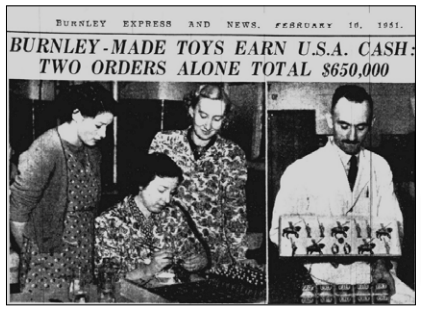
By 1951 the company was proclaiming9 that seventy-five percent of their output was for export markets, particularly to America. As the headlines to the newspaper article picture suggests, Johillco’s focus on the export of hollow-cast toy soldiers proved to be a lucrative venture for them. Incidentally, the lady shown seated in the photograph is Dolores Brown, the forewoman at Johillco through this period, and the inspiration behind the “Dorre” line of souvenir figures for the gift market
(which were painted in gold and black).
One of the ways in which Johillco achieved this amazing volume of exports was through distribution agreements with agents in the United States. One major U.S. wholesaler for Johillco was Milwaukee based Maurice “Morrie” D. Orum, who distributed product for both Johillco and F.G. Taylor; that is Frank Taylor of Taylor and Barrett, in distinctive yellow Midwest British Exporters boxes. Prior to 1950, Morrie Orum was a “fancy goods” trader selling a range of items from spring wound plastic trains10 to metal turtle toys11. In 1950, however, Orum reported12 that he had recently returned from a buying trip to England, and that he was now “handling a line of figures” and that there was “good reception for them”. By 1951 Orum was able to announce13 that he was back in England for the purpose of purchasing 120,000 lead soldiers, plus other items, for resale in the United States. Evidently a large part of this number was Johillco figures. Other U.S. distributors that supported the new owners of John Hill & Co. were J. J. Anthony and Gimbels Department Store. Both were also located in Milwaukee,
Wisconsin.
With the British government disincentives to sell toy products in the home market, and arrangements
established with distributors providing a good base volume of sales in the United States, the drive
for John Hill & Co. to export was secured.
It is not surprising, therefore, that a post-war John Hill & Co. export catalogue, dated from January 1950, should come to light. Other John Hill catalogues from 1951, 1952, 1953, and 1954 have also been found. Several aspects about the catalogue suggest that it was produced in a hurry, possibly to take advantage of the export opportunities which had suddenly arisen. A notation on the back cover shows that the catalogue was printed by the Standing brothers’ own printing company, Veevers & Hensman Ltd., of Burnley, Lancashire.
What is a little surprising is that this catalogue should surface in Australia. When compared to the company’s obvious volume of exports to the United States, Australia was unlikely to have been anything other than a small market for British toy soldier manufacturers. The overall suggestion given by the catalogue is that it was issued for the U.S. and Canadian markets. It may also have been used for other countries including Australia, although many of the listed figures never appeared in Australian stores.
In any case, a January 1950 dated catalogue gives us the opportunity to understand what toy soldiers the new Lancashire owners of the John Hill & Co. business were producing and marketing, and particularly those figures which appear to have only been produced in the immediate post-war recovery period.
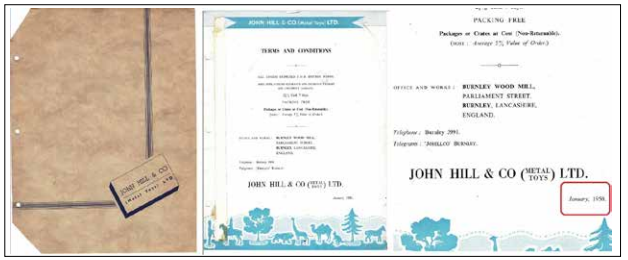
Firstly, the catalogue shows that the emphasis for the export market was on quality painted figures.
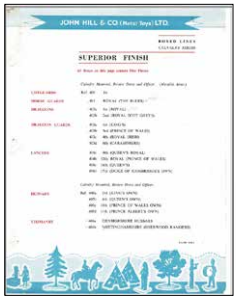
The catalogue contains eighteen pages, comprising sections listing:
- Superior Finish boxed soldier figures (Pages 1 to 7)
- Superior Finish boxed cowboy an Indian series figures (Pages 8 to 9)
- Superior Finish boxed farm series (Page 10)
- Superior Finish boxed zoo series (Page 11)
- Superior Finish, loose soldier lines (Page 12 to 13), with 4 second quality figures listed on page 13.
- Superior Finish, loose cowboy and Indian ‘large’ series (Page 14), with 11 second quality ‘small series’ figures also listed on page 14.
- Superior Finish, loose farm series (Page 15 to 17)
- Superior Finish, loose zoo series (Page 18)
Examples of the new range Johillco boxed sets from this immediate post-war period can be identified from the words “Scale Model Metal Soldiers. Designed and Manufactured by John Hill & Co. (Metal Toys) Ltd., ENGLAND” printed on the top of the box. By 1954, however, this box art was being replaced with the much more overtly “Johillco” branded box labels.
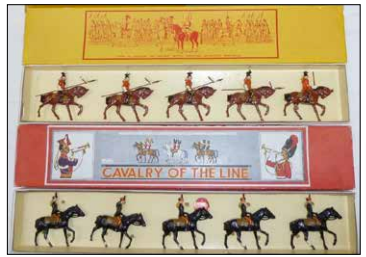
Set 404B 12th Lancers in John Hill (Metal Toys) box at bottom. (Bonhams Auctions, 2012)
The list of interesting, and some short-lived figures, in the 1950 catalogue includes a range of superior finish painted boxed sets of calvary regiments which had not been produced in the pre-war period, such as:
- 403d 6th (Carabiniers) Dragoon Guards,
- 405a 3rd (King’s Own) Hussars, and
- 406a the Denbighshire Hussars.
The Irish Guards 100b are listed, on page 2.
Although all these figures were probably just painting variations of the existing Lifeguard, Hussar and Dragoon figures, it is likely these sets were listed as a marketing exercise using “fancy” regiment names to try and attract customers in the
U.S. market. All these figures are also listed later in the catalogue as available in display boxes.
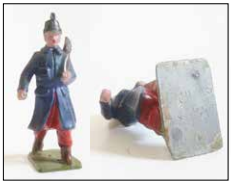
(Rob Wilson collection)
None of these figures are subsequently featured in the catalogues from 1951, 1952 or 1953 or a long listing of Hill figures for 1954.
If any John Hill & Co. collectors have figures painted in these variations, then you can now safely say they were only produced between 1946 and 1950. These paint variations very rarely, if ever, appear in the current day market and it is likely that they were produced only in very small volumes at the time.
There are also some apparently newly sculpted figures listed in the catalogue. These include light
infantry regiments listed under “Tartan Trews” and are boxed sets of eight figures with a movable arm
marching at slope, including an officer, with variations available of 107a Royal Scots Lothian Regiment,
107b King’s Own Scottish Borderers, and 107c Highland Light Infantry.
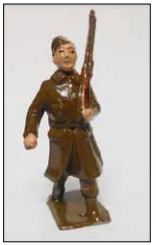
for the French Poilu (Norman Joplin collection)
Listed under “Rifle Brigade”, on page 3, are boxed sets of figures with a movable arm marching at trail, with an officer, and including variations of 108a Camerons (Scottish Rifles), 108b King’s Royal Rifle Corps, 108c Royal Irish Rifles, and 108d Princes Consort’s Own. This newly sculpted
Rifleman figure did not survive for long, and was discontinued in around 1954.
On page 13 there is also another very interesting new inclusion, figure 274 which is described as a ‘Poilu’. For those not familiar with the term, the word ‘Poilu’ was the nickname given to French WWI troops and means ‘hairy one’. The fashion was for French troops of the period to grow bushy beards as a sign of masculinity, however the nicely sculpted Johillco figure pictured is clearly not bearded. This very nice figure does not appear in the 1951 or any subsequent John Hill & Co. (Metal Toys) Ltd catalogues. The reason for its very short appearance is unknown, but it is a pity that few of this interesting figure were produced.
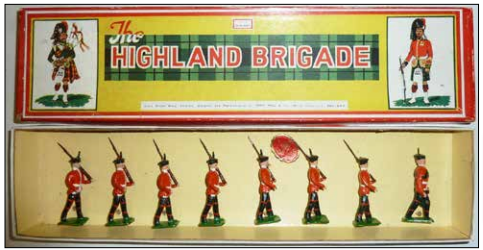
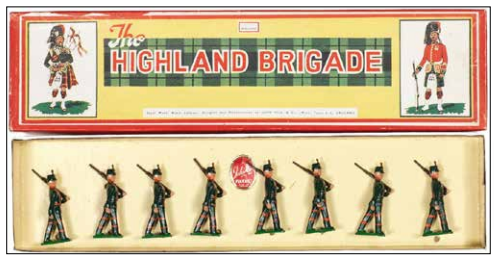
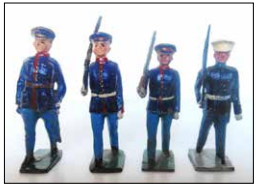
Officer, two versions of infantrymen and
post-war version (Norman Joplin collection)

The Poilu figure is clearly based on the Home Guard figure with a new head. The Home Guard figure is
not listed in any of the pre-war 1935 ‘pink’ catalogue, the 1940 Trade Letter, nor the 1950 export catalogue. It is likely that the Home Guard figure was only sold in Britain and therefore would not feature in a catalogue used outside of the U.K. The ‘Johillco England’ marking on the base of this
figure is identical to the Poilu, and while there are not many of the Home Guard figures in circulation, there are even fewer of the French Poilu to be found.
Now looking back to page 6 of the catalogue, we find several new figure releases to the Johillco range that had not been listed in any of the prewar catalogues.
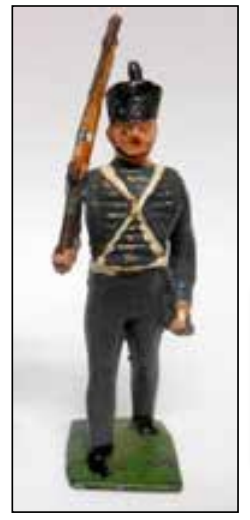
(Norman Joplin collection)
The first is Ref. 150 Marines in full review dress, marching at slope, with a trumpeter, all with movable arms. This set particularly demonstrates how this catalogue was really intended for the U.S. export market because it does not specify that the figures in this set are U.S. Marines rather than British marines. The fact that they are U.S. Marines is simply implied. A U.S. Marines figures had been produced in the pre-war period, although as with the Home Guard figure it had not been listed in any catalogues. The post-war figure is however, a new sculpting.
Also on page 6 is an entry for Ref. 158: West Point Cadet (movable arm). The record for this figure
has been added in by hand after the catalogue was printed, which suggests that the figure is likely to
have first been produced in 1950. Johillco had in fact also produced a West Point cadet in the pre-war
period, but it had not been listed in any catalogues, and the post-war figure is clearly a new sculpt. It was a natural addition to a Johillco range marketed to the U.S. export market, and was probably never exported to other countries outside of North America because, along with the post-war Marine, they never appear in those markets.
As usual, John Hill & Co. were catching up with Britains who had released their West Point cadets in
summer dress Set 299 back in 1927. Despite the rather light blue colour of the uniform on the Johillco version, the figures are attractive, and a boxed set would also have featured a sword bearing ‘officer’ not included with the Britains set. A trumpeter version with a movable arm is also shown in the Great Book of Hollow-cast Figures by Norman Joplin.
In addition to the handwritten listings of the West Point Cadet and the Knight in Armour, note the error regarding the listing of the Gladiators. This omits to show the Reference number, presumably Set 156. This printing error is very suggestive of the catalogue being a last-minute issue.
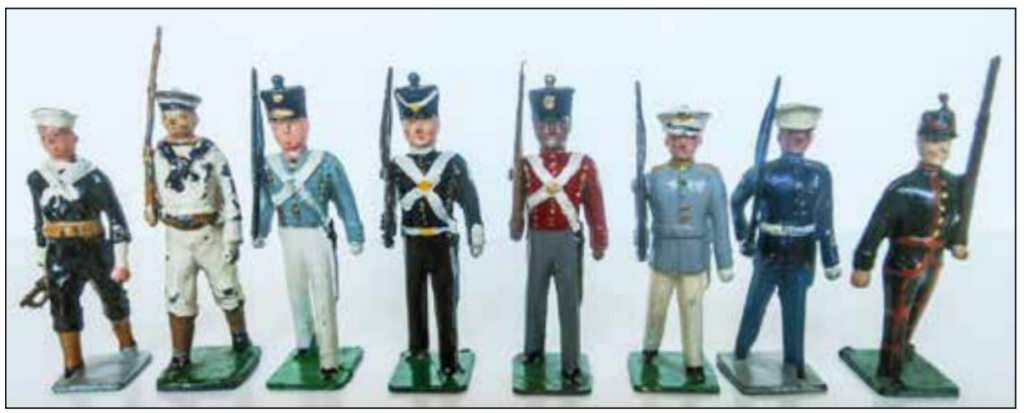
Left to Right: Set 145 (1952) Sailor at trail and marching; Set 158 (1950) West Point Cadet
marching; Set# unknown (1952) 49th New York Regiment; Set# unknown (1952) Waterloo British
Infantryman; Set# unknown (1952) the Citadel Military College, South Caroline; Set 150 (1950) Marines at slope; Set 108a (1950) Camerons (Scottish R50) Camerons (Scottish Rifles) at slope. (Norman Joplin)
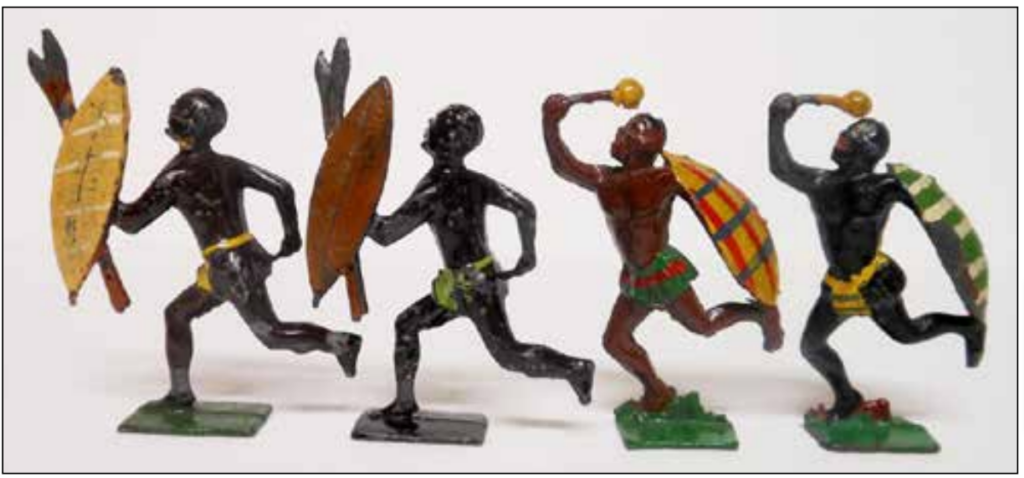
(Norman Joplin collection)
The next set in the list Ref. 151 Sailors in tropical kit, kneeling and standing at ready (movable arms),
are meant to represent U.S. sailors. This set re-uses the pre-war British white jacket kneeling and standing at ready figures which do not have movable arms, but strangely the catalogue does not mention the new figures that were included in the set that did have the movable arms; one marching at slope, and another walking at trail, as shown above. The next new sculpt figure is the Zulu with knobkerry and shield Ref.
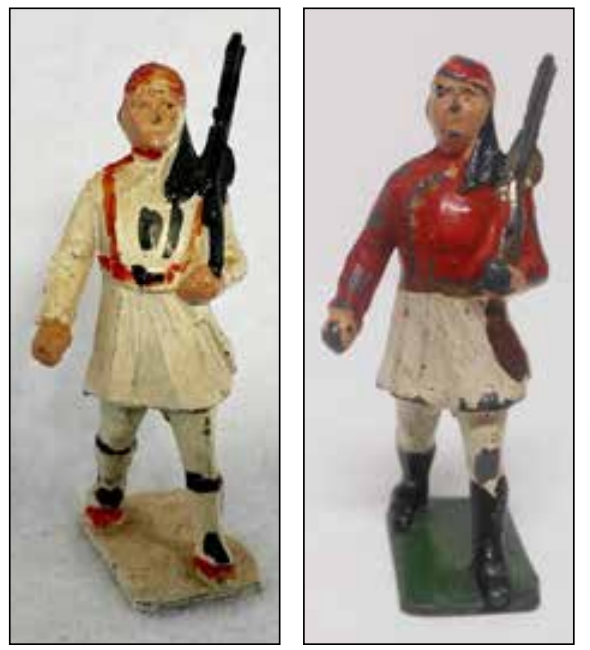
(Richard Forrester collection) on the right
the pre-war version from Norman Joplin’s
collection
This is a rather ungainly figure and very different from the pre-war version of the Johillco Zulu. This figure was painted in black and brown paint versions. Next of interest is the Greek Evzone, Marching at Slope: Ref. 154. This will be a familiar figure to John Hill & Co. collectors, and while it is very similar
in its stance to the Home Guard figure with rifle at slope on the left shoulder, it is clearly a different moulded figure. As with the Marine and West Point Cadet, a pre-war but un-catalogued version had been available, painted wearing a red jacket.
Strangely, the next figure, Ref. 165: Knight in armour (movable arm) is also a handwritten entry. In 2019, Vectis Auctions sold a rare box set Ref: 165 – Knights on Foot, comprising eight Knights with Movable Halberd Arms Depicted in Gold Armour, which were the old version 1935 catalogue listed 171L knight on foot, and not a set of the new Crusader knight figures which Johillco had released by
Perhaps the reason for the handwritten entry into the catalogue is that the new owners of John Hill & Co. had planned to drop the knights from the range, or it may have been mistakenly left out of the printed catalogue. The range of Johillco’s Wild West figures also changed with the new ownership. A comparison between the pre-war and post-war listings shows, firstly, that the large 70mm scale figures were dropped from the range and were replaced with eleven smaller 48mm scale second quality painted figures that were sold as loose counter pack style figures and were therefore cheaper to produce and sell. These figures were simply a scaled down version of the existing 54mm figures.
The other change was the introduction of four new Wild West figures with movable arms; Ref 604 Cowboy with rifle (at trail); 605 Cowboy with revolver; 607 Cowboy with whip, and 619 Indian chief with a knife.
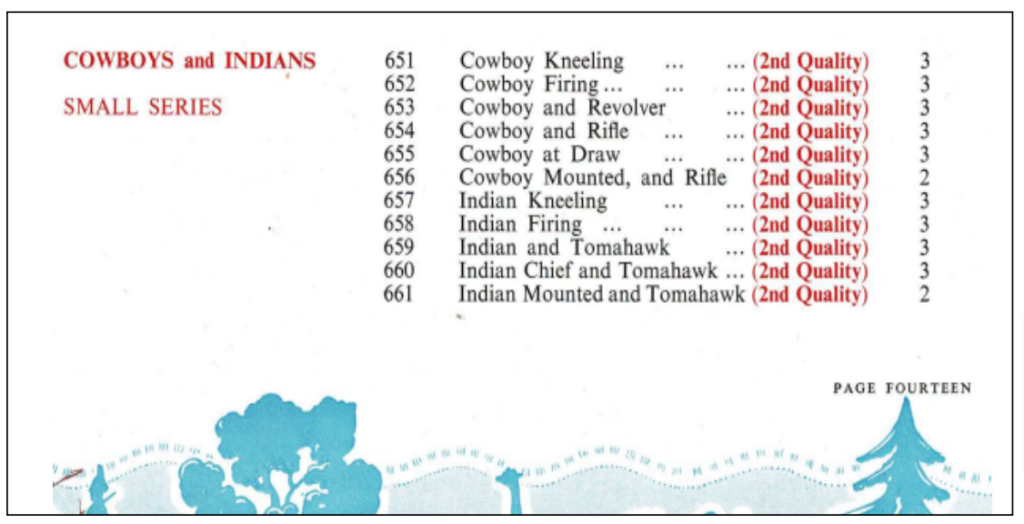
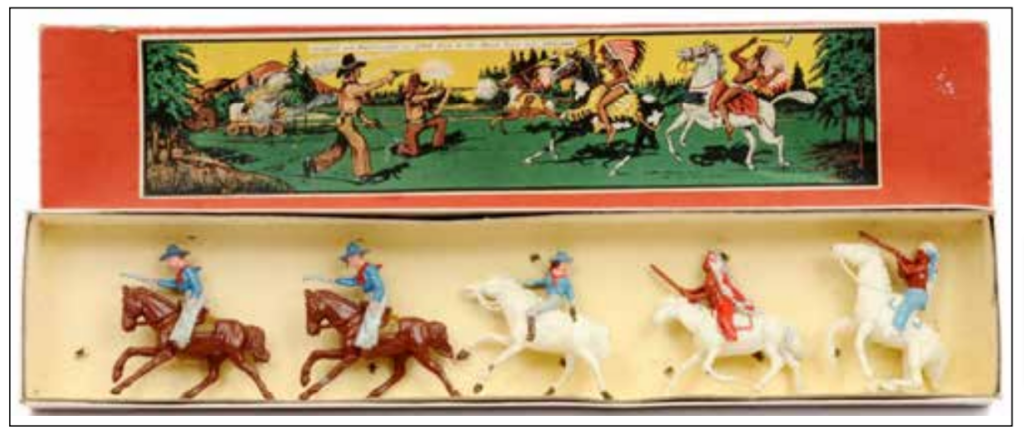
The box art for the Wid West figures in this immediate post-war period also had the same John Hill & Co (Metal Toys) Ltd. words printed on the label.
In the Farmyard and Zoo series, the only new figures issued at this time were a Grocer, and a very nice model of a rolling Panda. This suggests that the new owners of Johillco were quite confident in the level of demand for their existing figures in these two areas of their product range, and therefore did not feel there was a need to make significant changes for the U.S. or Canadian export markets.
Understandably what is missing from Farmyard and Zoo range in the 1950 catalogue are the more perhaps characteristically British civic figures and accessories, such as the Thatched cottage, Shepherd
and lamb, Witch, Witch’s cauldron, Traffic Signs, Milestones, Tennis Player, Golfer, Punt boat, and
Summerhouses, although strangely one of the Summerhouse Tables (Ref. 165) appears in the catalogue.
Missing from the Zoo series are a rather random selection of animals such as the Frogs, Tortoise,
Rats, Rabbit, Eagle, Leopard, Hippopotamus, Rhinoceros, Kneeling Camel, Sitting bears, and the Walrus.
Conclusion
The 1950 dated catalogue provides a glimpse into the decision making of the new owners of John Hill & Co in this immediate post-war period. With economic conditions still so challenging at home in Britain, the only viable option for James Standing and Jack Cooper was to export, and predominantly to the dominant post-war market of the United States and Canada. Standing and Cooper were clearly successful in their export venture, with the help of agents such as Morrie Orum’s Midwest British Importers, but they had to decide quickly which range of product would be most successful to
war weary consumers.
The 1950 catalogue shows that the company tried several strategies to work out what the best export product range would be. The boldest, but also quite short lived of these strategies was to have a long list of ‘fancy’ British regiments which were painted to a first-class level. Standing and Cooper also added the nice new Poilu and Rifleman, figures but surprisingly ceased to issue them from 1952 while persisting with other odd-looking figures such as the new replacement Zulu.
For John Hill (Metal Toys) Ltd., the immediate post-war period of the 1950s started with a period of remarkable success, as suggested by the export catalogue, but would end with significant challenges
for the company coming from the manufacturers of cheaper plastic figures.
knife.
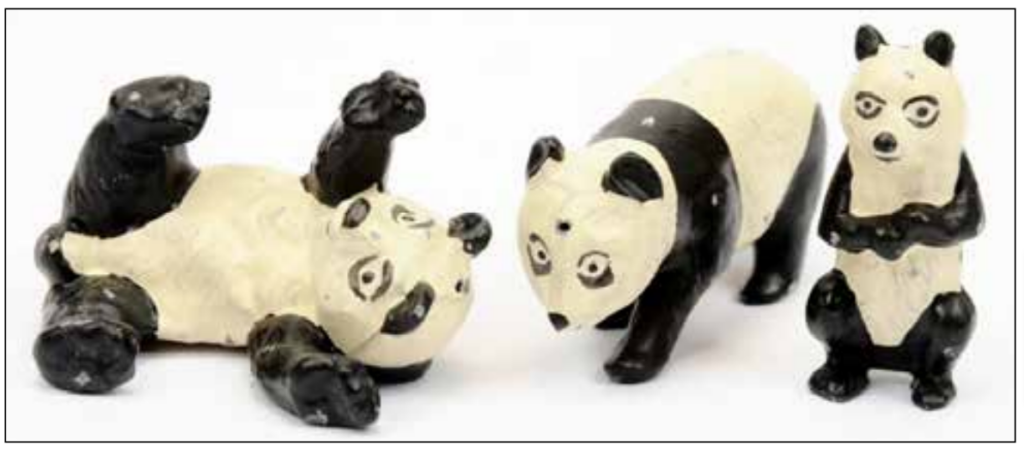
(Vectis Auctions, 2020)
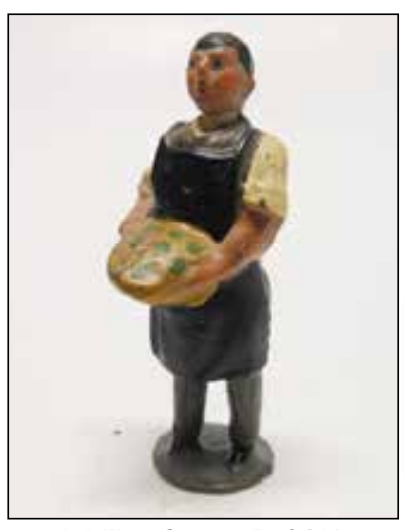
(Norman Joplin collection.)
1 Burnley Express, 10 February 1951, Pg 5. FindMyPast British Newspaper Archive.
2 British Toy Trade Transition. Birmingham Daily Post, 9 June 1945, Pg 2.
3 Brown, Kenneth. D. The British Toy Business. The Hambledon Press, London (1996). Pg 154.
4 Burnley Express, 11 May 1946, Pg4. FindMyPast British Newspaper Archive.
5 Barnoldswick & Earby Times, 13 September 1946, Pg 2. FindMyPast British Newspaper Archive.
6 Burnley Express, 27 November 1946, Pg 4. FindMyPast British Newspaper Archive.
7 Britain’s soldiers are winning a new kind of battle. Belfast Telegraph, , 28 February 1956, Pg 4. FindMyPast British Newspaper Archive
8 Burnley Express, 10 April 1948, Pg 1. FindMyPast British Newspaper Archive.
9 Burnley Express, 10 February 1951, op.cit.
10 Advertisement, The Billboard, 27 March 1948, Google Books.
11 Advertisement, The Billboard, 30 April 1949, Google Books.
12 Merchandise Topics, The Billboard, 25 March 1950, Google Books.
13 Soldiers versus Cowboys, The Yorkshire Post and Leeds Mercury, 9 January 1951, FindMyPast British Newspaper Archive.
